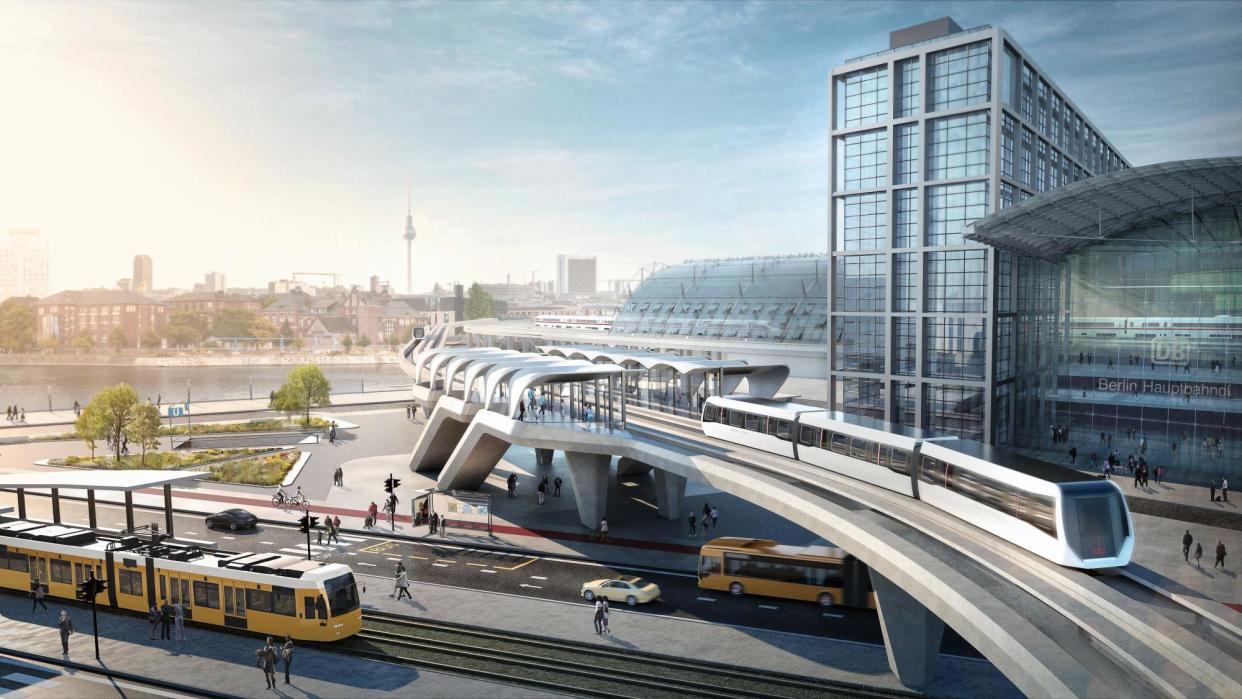Berlin’s plan for driverless magnetic trains derided by climate groups

Plans for a driverless magnetic train that would swoop through Berlin and carry passengers and goods are under way as part of the local government’s attempts to boost the German capital’s green credentials.
The project, put forward by the city’s new conservative-led government, is said to have sufficient political backing and, say its backers, would help Berlin achieve its goal to become net zero by 2045.
A 5-7km pilot stretch of magnetic levitated railway (maglev) at an estimated cost of €80m-€85m (£70m-£74m) could be in use within two years, Dirk Stettner, the parliamentary faction leader of the Christian Democrats (CDU) has said, citing the advantages of a magnetic train above the existing, extensive underground and overground networks.
At a time when Berlin’s transport company, the BVG, is so short of drivers that it has reduced its timetable by about 7%, Stettner said the fact that the train was self-driving as well as cheaper and easier to construct than an underground line was a further advantage.
But environmentalists have condemned the plans, countering CDU claims that the trains were futuristic and calling them expensive, energy-hogging and vain instead.
The project seeks to resurrect the so-called M-Bahn of the 1980s, from Kreuzberg to Tiergarten in the western section of the city. A test-stretch was running by 1984, and was in regular use.
It was dismantled in 1991, two years after the fall of the Berlin Wall, to allow for the restoration of the U2 underground line, which had been cauterised by the erection of the notorious cold war barrier that cut the city in two.
At a recent presentation of his plans, including slick architectural sketches, Stettner said there were many ideas on how to practically make use of a new M-Bahn in a city that retained the scars of division.
“We want to choose a good test route, which makes sense from a logistical point of view, and to ensure that it stays as part of a whole network and is not seen as temporary,” he said.
Ute Bonde, the head of the VBB transport network that links the neighbouring federal states of Berlin and Brandenburg, voiced her support for the plan and said Berlin, which remained heavily dependent on cars, was in need of innovative ideas to persuade people out of their cars and on to trains.
“This could be a useful extension to the existing railways in the city. It is quiet, cheaper and could be constructed as either an elevated or a low-level train, and could be run on solar power,” she told RBB24 radio station.
But environmentalists have questioned the veracity of the argument that the construction of the M-Bahn would contribute to better climate protection. They called instead for the expansion of the existing extensive infrastructure of overground and underground trains, trams and buses.
Tilmann Heuser of the Association for Environmental and Nature Protection said the idea was a “mockery for everyone who is serious about swiftly improving climate action”. He added: “It can’t be our goal to finance absurd projects like this.”
Heuser called for a more carefully thought through use of the climate funds. “The climate crisis is too much of a threat for us to play with it as if it was an excuse for a bit of fun. Fantasy projects made out of concrete will do nothing to contribute to climate protection goals,” he said.
Various inventors have been behind the creation and development of magnetic levitation rail, from the French American Émile Bachelet, whose electromagnetic levitation and propulsion train was first demonstrated in 1912, to the English inventor Eric Laithwaite, whose maglev creation was the first to operate commercially in Birmingham in the 1980s, later closing down over reliability issues.
German inventors are seen as the force behind modern monorail systems. But they are far more widespread elsewhere, such as in China and Japan, than in Europe.
In the mid-90s, there were plans for the first stretch of magnetic rail to link Berlin and Hamburg in less than an hour. However, the project, which had many opponents, including environmentalists, was abandoned in 2000 due to cost concerns.
The new M-Bahn project could fall victim to a similar lack of funding before it has even properly begun, amid uncertainty over the future of the federal government’s multibillion-euro climate funds, its share of which the Berlin government was hoping to use for the scheme.
Last month Germany’s highest court blocked the federal government’s plan to shift leftover Covid-era aid to fund projects to tackle the climate emergency, leaving many policy decisions in limbo.
Taz, the Berlin daily, called it an “effrontery” that the project should be financed from climate funds.
“If the funds survive the court’s earthquake decision, they should be used to finance efficient ways to reduce CO2 emissions, and to adapt to climate change, not for willy-nilly ‘perhaps nice-to-haves’,” it wrote in an editorial.
The M-Bahn was the equivalent of the CDU “pointing the middle finger at the faces of climate protection advocates”, it added.


